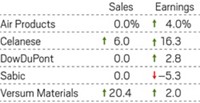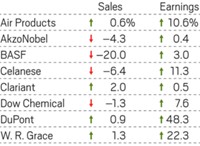Advertisement
Grab your lab coat. Let's get started
Welcome!
Welcome!
Create an account below to get 6 C&EN articles per month, receive newsletters and more - all free.
It seems this is your first time logging in online. Please enter the following information to continue.
As an ACS member you automatically get access to this site. All we need is few more details to create your reading experience.
Not you? Sign in with a different account.
Not you? Sign in with a different account.
ERROR 1
ERROR 1
ERROR 2
ERROR 2
ERROR 2
ERROR 2
ERROR 2
Password and Confirm password must match.
If you have an ACS member number, please enter it here so we can link this account to your membership. (optional)
ERROR 2
ACS values your privacy. By submitting your information, you are gaining access to C&EN and subscribing to our weekly newsletter. We use the information you provide to make your reading experience better, and we will never sell your data to third party members.
Business
Anemic Demand Slows Earnings
Customer destocking returned in the fourth quarter, squeezing chemical company profit margins
by Melody M. Bomgardner
February 27, 2012
| A version of this story appeared in
Volume 90, Issue 9

U.S. chemical executives blamed macroeconomic forces and seasonal slowness for a lackluster fourth quarter of 2011. At the 20 firms tracked by C&EN, sales grew an average of 9.3%, and earnings drifted up 4.2% compared with the year-ago quarter. The sector with the strongest showing was agriculture, where the fertilizer companies CF Industries and Mosaic saw earnings soar 119.5% and 36.5%, respectively. Without those results, the other 18 firms’ combined earnings declined almost 10% year-over-year.
Dow Chemical, the largest U.S. chemical firm by revenue, had the steepest decline in earnings for the quarter, down 46.3% to $289 million. Dow Chief Executive Officer Andrew N. Liveris tried to explain the poor performance as he led off a conference call with investors. “The fourth quarter presented our industry with a challenging operating environment,” he said. “New uncertainty was driven mostly by the sovereign debt issues in Western Europe, coupled with traditional seasonality. It led to substantial destocking across supply chains, as customers reduced inventories prior to year end.”
Midway through the quarter, demand for Dow’s products was so weak that it became expensive to run plants at the needed operating rates, which had declined to 69% from 89% earlier in the year. Dow aggressively shifted its pricing strategy to push volume out the door, according to Laurence Alexander, chemicals analyst at the investment firm Jefferies & Co. “As a result, operating rates rose to 76% in December. This resulted in lower margins across segments: most notably in coatings and infrastructure solutions, and performance materials,” he wrote in a note to investors. Dow’s profit margin for the quarter narrowed to 2.1% from 3.9% in the fourth quarter of 2010.
DuPont also saw skinny margins in the fourth quarter. Although sales grew 13.8%, earnings fell by 29.8% to $325 million. CEO Ellen J. Kullman blamed the weaker earnings on a higher tax rate in 2011. To explain low volume growth, she pointed to cautious customers rather than slow economic growth. Kullman reminded analysts in a conference call last month that the company had already revised its guidance in December, when it warned about “market softness in electronics and customers’ conservative year-end cash management with further destocking in the polymer and industrial supply chains.”
Meanwhile, both executives said the end of the year was unusually good for their agriculture businesses, thanks to strong demand from Latin America. Dow’s seed business enjoyed a sales increase of 22% compared with the year-ago quarter. DuPont’s sales of seeds and agricultural chemicals increased 8% in the quarter and 23% in the second half of 2011. In a note to clients, Deutsche Bank analyst David Begleiter said DuPont’s strong finish in Latin America was unexpected and helped the company beat consensus expectations for the quarter.
The same wave from the Southern Hemisphere buoyed FMC Corp.’s results in the fourth quarter. The company’s sales of agricultural chemicals grew 22% in Latin America on strong demand in Brazil and new product introductions from a joint venture in Argentina. FMC also benefited from demand for its industrial chemicals, especially from overseas buyers of soda ash. In addition, the firm profited from higher prices for peroxygens, after it shifted its product mix toward specialty peroxygens. Overall, FMC saw the second-highest growth in earnings of the companies tracked by C&EN, up 40.0% to $112 million.
In contrast, the destocking in the polymer supply chain that plagued DuPont was also evident at Albemarle. Slack volumes for the firm’s polymer additives resulted in 5% lower sales, despite higher prices. Otherwise the firm had a strong quarter, raising sales and earnings by 17% apiece compared with the fourth quarter of 2010. Higher prices boosted sales of catalysts 25% in the quarter. Both prices and volumes increased in Albemarle’s fine chemicals segment.
Industrial gas customers made the fourth quarter a good one at Praxair. In North America, sales increased 7%, which the firm attributed to growth in the manufacturing, energy, chemicals, and metals markets. Higher sales of specialty coatings for aviation and oil and gas drilling applications also contributed to earnings growth of 6.7%.
But at industrial gases rival Air Products & Chemicals, seasonality in electronics, performance materials, and merchant gases pushed sales in the segment down by 7%, which was just about offset by higher volumes in tonnage gases caused by the opening of new plants. Overall, earnings slipped by a little more than 1% compared with the year-ago quarter. “As we expected, economic growth continued to slow this quarter, depressing volumes and limiting earnings growth,” commented Air Products CEO John E. McGlade.
At Celanese, earnings declined 6.8% in the quarter due in part to slow sales in Europe. “This led to a sharp inventory destocking in the company’s acetyl intermediates segment, as well as a modest impact to volumes in the advanced engineered materials segment,” the company told investors.
Volume declines were also evident at Huntsman Corp., but higher prices for polyurethanes, performance products, and pigments more than offset the impact, raising revenues by 9.1% and earnings by 13.3% compared with the 2010 fourth quarter. CEO Peter R. Huntsman described customer destocking as “aggressive,” but he assured investors that Huntsman’s businesses would revive with the improving global economy.
Meanwhile, the coatings market was a mixed bag for paint-oriented companies such as PPG Industries, which reported flat volumes year-over-year. Sales in Europe dropped by 1%, but the firm saw strengthening global demand in markets including aerospace, automotive manufacturing, and general industry. Construction activity in developed regions was still anemic, PPG told investors. In total, quarterly revenues increased 16.9%, and earnings grew by 5.4%.
PPG isn’t likely to see a rebound in U.S. construction activity for some time. In early February, Federal Reserve Chairman Ben S. Bernanke included a startling statistic in testimony to Congress. “Since 2009, the pace of single-family housing starts has averaged less than 500,000 units per year. During the 15 years before the financial crisis, the pace of single-family starts had never fallen below 1 million units per year.”
Bernanke added that declines in home values may be causing a $200 billion to $375 billion reduction in annual consumer spending. On the other hand, in 2011, the U.S. economy added 160,000 jobs per month, and the unemployment rate fell by about 1%. That small advance likely contributed to higher personal spending in the fourth quarter. According to the Bureau of Economic Analysis, consumer spending increased 2.0% in the fourth quarter, after a third-quarter increase of 1.7%. Spending on durable goods increased 14.8%, compared with an increase of 5.7% in the third quarter. Overall, the gross domestic product (GDP) increased by an estimated annual rate of 2.8% in the fourth quarter.
As the U.S. economy crawled out of the recession, chemical firms depended on developing countries such as China and Brazil to offer strong, consistent growth. But as 2011 drew to a close, that approach began to look less reliable. In the fourth quarter, DuPont’s Kullman told analysts, “Auto builds were essentially flat, with gains in the U.S. and Japan offset by declines in every other region.” In fact, auto manufacturing in the U.S. increased 10% in 2011 compared with 2010, according to J.D. Power & Associates, a marketing information company. J.D. Power anticipates 6% growth in 2012.
While growth in the U.S. economy is accelerating—albeit from a low base—China’s staggering rate of growth is abating. China’s National Bureau of Statistics reported that the country’s fourth-quarter GDP growth slowed to 8.9% from 9.1% in the third quarter.
Overall, chemical executives say they expect that the flat volumes that dogged the industry in the fourth quarter will continue into the spring and possibly even the summer of 2012. Anemic sales in Europe may continue even longer than that. End markets are expected to stabilize or accelerate in the second half of 2012.
PPG CEO Charles E. Bunch told investors that he expects moderate strengthening in the U.S. but forecasts that global growth will remain uneven across regions and industries. “In the aggregate, emerging-region growth rates are expected to remain high compared to developed regions,” he said, “but more moderate and erratic than they have been in the past.”







Join the conversation
Contact the reporter
Submit a Letter to the Editor for publication
Engage with us on Twitter